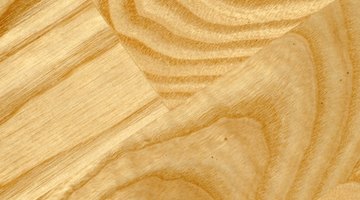The Simple Ways to Stain Tongue & Groove Boards
The idea behind staining wood versus painting it, is to achieve a darker, but still natural color for your boards. Tongue and groove boards are a special case in the sense that they need room to expand and contract with moisture levels in the air, and a stain that causes additional swelling can interfere with the way the boards fit together. In order to avoid this kind of problem, use a quality oil stain as opposed to a water or synthetic stain. (Ref 1 p 212 graph 6)
Foam Brush

Using a foam brush is possibly the best way to apply stain with the most accuracy and least mess. The foam absorbs the stain like a sponge and holds it until it is pressed on the board. This avoids drips and runs, as long as you do not overload the brush. Foam brushes also come in a variety of widths, making it simple to choose one appropriate for the task at hand. (Ref 2 vid clip min 2)
Rag
A clean rag is an effective way to apply stain to tongue and groove boards. While it does not always offer the ease that the foam brush does, it is something everyone has on hand. Choose an absorbent cloth so that it acts like a sponge and soaks up the stain for application. Absorbent cloths, like terry, microfiber or dish washing rags, reduce mess while applying the stain. Also use a cloth so you do not plan to reuse, as the stain permanently stains the rags.
Paint Brush
Stain may also be painted onto the boards. Since a paint brush is not as absorbent, drips are a problem. Avoid them by not loading too much stain onto the brush at one time. A paint brush used for stain can be cleaned with mineral spirits and used again and again. Angled paint brushes may also be better suited for getting into tight corners, simplifying your stain application.
Your Hand
Some people prefer the hands-on approach to staining. Wearing vinyl or latex gloves is recommended if you do not want your hands to match your tongue and groove wood. Simply dip your fingers into the stain and smear it onto the wood surface. You may also wear a cloth glove over your disposables for some absorbency. Absorbency in the applicator, whatever it may be, increases the smoothness with which your stain goes on. (Ref 3 section Stain)
References
Resources
Writer Bio
Angela Baird has been writing professionally since 1995. She has a wide range of life experiences from work with abused animals with the Humane Society, to more than 20 years of hands-on experience in the culinary arts. In addition, she keeps horses and does her own home improvements and home gardening.
Photo Credits
- wood image by Zbigniew Nowak from Fotolia.com
More Articles



